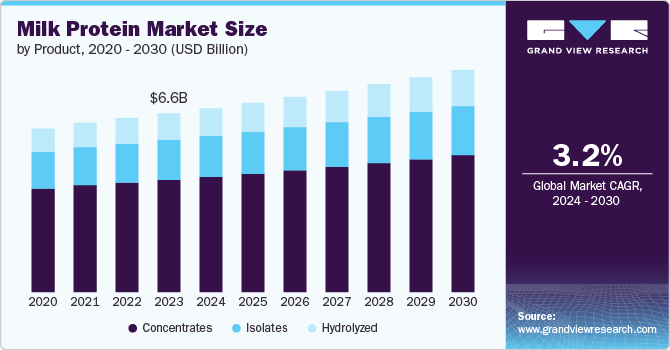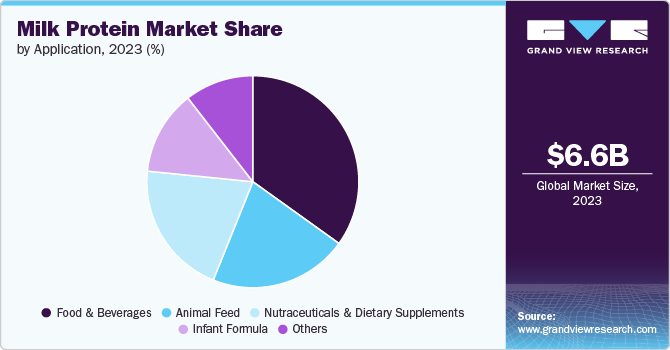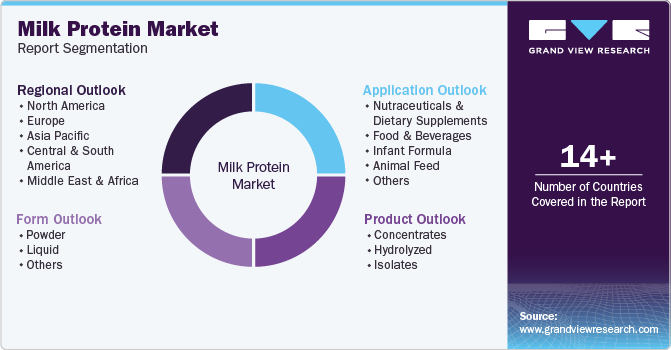
Milk Protein Market Size, Share & Trends Analysis Report By Product (Concentrates, Hydrolyzed, Isolates), By Form (Powder, Liquid), By Application (Nutraceuticals & Dietary Supplements, Food & Beverages), By Region, And Segment Forecasts, 2024 - 2030
- Report ID: GVR-4-68040-462-3
- Number of Report Pages: 100
- Format: PDF
- Historical Range: 2018 - 2022
- Forecast Period: 2024 - 2030
- Industry: Consumer Goods
Milk Protein Market Size & Trends
The global milk protein market size was estimated at USD 6.63 billion in 2023 and is projected to grow at a CAGR of 3.2% from 2024 to 2030. One of the primary drivers of the market is the increasing health consciousness among consumers. There is a widespread awareness of the importance of protein in maintaining overall health, leading to a rise in the consumption of protein-rich products. Milk proteins, which include casein, whey protein, and milk protein concentrates, are recognized for their high nutritional value, complete amino acid profile, and digestibility, making them ideal for various dietary applications.

Consumers, particularly in developed markets, are increasingly adopting high-protein diets for muscle maintenance, weight management, and overall wellness. This trend is especially prevalent among fitness enthusiasts, athletes, and individuals following specific dietary regimens such as keto or paleo diets. The global sports nutrition market extensively uses milk protein in supplements and powders and its continued growth is expected to fuel demand for milk proteins. Manufacturers have responded to this by developing a wide range of milk protein-enriched products, from shakes and powders to bars and ready-to-drink beverages.
Functional foods and beverages, which provide health benefits beyond basic nutrition, are gaining significant traction globally. Milk proteins play a crucial role in this segment due to their multifunctional properties such as emulsification, foaming, and gelling. The ability of milk proteins to enhance texture, stability, and nutritional content makes them ideal ingredients in a variety of functional food applications, including fortified dairy products, meal replacements, and protein-enriched snacks. Manufacturers are increasingly focusing on innovation to meet the rising demand for functional foods. For instance, Arla Foods Ingredients Group offers a range of milk protein-based ingredients designed for protein bars that maintain their texture and softness over time, a common issue with high-protein snacks. This move addresses the growing demand for convenient, on-the-go products that offer both taste and health benefits.
Technological advancements in the processing and extraction of milk proteins have played a crucial role in the market's growth. Traditional methods of extracting milk proteins were often inefficient, resulting in lower yields and higher costs. However, innovations in filtration, ultrafiltration, and microfiltration technologies have improved the purity and functionality of milk proteins, making them more suitable for a wider range of applications. For instance, advanced membrane filtration technologies have enabled manufacturers to produce highly concentrated whey protein isolates and caseinates with minimal denaturation, preserving their nutritional integrity. These innovations have also allowed for the development of lactose-free and fat-free milk protein products, catering to consumers with dietary restrictions. As a result, manufacturers can offer more diverse product portfolios that meet the specific needs of different consumer groups, from athletes to individuals with lactose intolerance.
Market Concentration & Characteristics
The market has seen significant innovation in product formulation and processing. Advances in protein extraction, clean-label formulations, and specialized protein variants (such as hydrolyzed and isolate proteins) cater to diverse applications. Innovations in flavor, texture, and sustainability practices also boost demand, with companies focusing on creating high-performance, and allergen-free products to meet evolving consumer preferences for health and wellness.
Mergers and acquisitions (M&A) have been active in the global market, with companies seeking to expand their product portfolios, access new technologies, and increase market presence. Strategic acquisitions have enabled firms to diversify their offerings into high-growth areas like sports nutrition, nutraceuticals, and infant formula.

Regulations play a critical role in the market, ensuring product safety, quality, and labeling compliance. Authorities like the FDA, EFSA, and WHO regulate protein content claims, allergen labeling, and infant formula standards. Stringent regulations on clean-label and organic certifications drive manufacturers to meet consumer demand for transparency. Compliance with dairy processing standards is essential for maintaining market credibility, particularly in nutraceuticals and infant nutrition.
Plant-based proteins, such as pea, soy, and almond proteins, are notable substitutes for milk proteins, especially among vegan and lactose-intolerant consumers. As plant-based diets grow in popularity, these alternatives offer similar protein content but vary in amino acid composition and functional properties. While milk proteins remain dominant due to their complete amino acid profile, innovations in plant protein extraction and formulation are gaining market share.
The market has witnessed a series of innovative product launches, particularly in high-protein snacks, functional beverages, and sports supplements. New offerings cater to consumer trends such as clean-label, organic, and allergen-free formulations. Products like ready-to-drink protein shakes, protein-fortified dairy, and infant formulas have gained popularity, driven by increased demand for convenient and nutritious options across various age groups.
Regional expansion is driven by growing demand in Asia Pacific and Latin America, where rising disposable incomes and health awareness fuel interest in protein-enriched products. Companies are increasing production capacities and distribution networks in emerging markets like China and India. In developed regions, North America and Europe remain key markets, with firms focusing on premium offerings, such as organic and hydrolyzed proteins, to capture niche consumer segments.
Product Insights
Based on product, the milk protein concentrates (MPCs) segment led the market with the largest revenue share of 62.80% in 2023, due to their versatility and broad applicability across different industries. MPCs contain a higher concentration of protein along with other essential nutrients such as calcium, phosphorus, and magnesium. Their well-rounded nutritional profile makes them a popular choice in various sectors like food and beverages, sports nutrition, infant formula, and even animal feed. Milk protein concentrates are cost-effective compared to hydrolyzed and isolate proteins, they are relatively more affordable to produce, making them an attractive option for manufacturers looking to incorporate high-protein ingredients without significantly increasing production costs. In addition, MPCs offer functional benefits such as improved emulsification, water-binding properties, and texture enhancement, making them a preferred choice in food manufacturing, especially in dairy-based products like yogurts, cheeses, and protein bars.
The hydrolyzed milk protein segment is expected to grow at the fastest CAGR of 4.5% from 2024 to 2030, due to its specific health benefits and application in niche markets. Hydrolyzed proteins are pre-digested, meaning they are broken down into smaller peptides or amino acids, making them easier for the body to absorb and digest. This property makes hydrolyzed milk protein an ideal choice for individuals with digestive sensitivities, such as infants, elderly populations, or those with lactose intolerance. In the sports nutrition and clinical nutrition sectors, hydrolyzed proteins are highly valued for their fast absorption rate, which supports muscle recovery and growth post-exercise. This has led to their increased adoption in sports supplements, protein powders, and medical nutrition products.
Form Insights
Based on form, the powdered milk proteins segment led the market with the largest revenue share of 53.4% in 2023, due to their long shelf life, ease of transportation, and versatile application across industries. The stability of powdered milk protein makes it a preferred choice for manufacturers in sectors such as food and beverages, nutraceuticals, and dietary supplements. In powdered form, milk protein can be easily mixed into products such as baked goods, beverages, protein bars, and meal replacements. Another key factor driving the dominance of powdered milk proteins is their cost-effectiveness in storage and distribution. Compared to liquid forms, which require refrigeration and have a shorter shelf life, powdered forms can be stored for extended periods without refrigeration, reducing logistics and storage costs. This makes powdered milk proteins a highly attractive option for both manufacturers and retailers, especially in regions with limited cold chain infrastructure.
The liquid milk proteins segment is expected to grow at the fastest CAGR of 3.1% from 2024 to 2030, due to the increasing demand for ready-to-drink (RTD) protein beverages and fortified dairy products. Liquid milk proteins are particularly popular in the sports nutrition and functional beverages markets, where consumers seek convenient, on-the-go nutrition solutions. The rising demand for high-protein beverages, such as protein shakes, smoothies, and fortified milk drinks, is driving the growth of liquid milk protein. Companies are increasingly developing RTD protein beverages that offer high-quality protein in a convenient liquid format. These products cater to consumers with active lifestyles who prioritize convenience without compromising on nutrition.
Application Insights
Based on application, the food and beverages segment led the market with the largest revenue share of 34.9% in 2023, driven by the growing demand for protein-enriched products in both developed and emerging markets. Milk proteins are widely used in various food products, including dairy products, snacks, bakery items, and beverages, due to their functional properties such as emulsification, texture enhancement, and nutritional value. In the dairy sector, milk proteins are essential for producing products like cheese, yogurt, and ice cream. The increasing consumer demand for high-protein dairy products, particularly in developed markets such as North America and Europe, has further boosted the use of milk protein in the food and beverages industry.

The nutraceuticals & dietary supplements segment is expected to grow at the fastest CAGR of 3.9% from 2024 to 2030. The nutraceuticals and dietary supplements market is experiencing rapid growth, and milk proteins play a crucial role in this sector. The rising awareness of preventive healthcare, coupled with the increasing popularity of protein supplements for fitness and wellness, is driving the demand for milk protein-based nutraceutical products. Whey protein isolates and concentrates are among the most widely used ingredients in protein powders, shakes, and bars, which are popular among athletes, fitness enthusiasts, and individuals looking to increase their protein intake for muscle building, weight management, or overall health.
Regional Insights
North America dominated the milk protein market with the largest revenue share of 32.6% in 2023. North America holds the largest share of the global market, driven by the region’s strong demand for high-protein foods and beverages, advanced food processing industry, and high consumer awareness of health and nutrition. U.S. is a key market within North America, with a large population of health-conscious consumers and a well-established dairy industry. The sports nutrition market in North America, which extensively uses milk proteins in supplements, powders, and RTD beverages, is one of the primary drivers of market growth. In addition, the growing demand for protein-enriched dairy products, functional foods, and clean-label products has further bolstered the use of milk proteins in the region.
Asia Pacific Milk Protein Market Trends
The milk protein market in Asia Pacific is expected to grow at the fastest CAGR of 3.7% from 2024 to 2030 driven by rapid urbanization, increasing disposable incomes, and changing dietary patterns in emerging economies such as China and India. The rising demand for high-protein foods, driven by increasing health consciousness and the adoption of Western dietary habits, is a key factor contributing to the market's growth in the region. The expansion of the sports nutrition and functional food markets in Asia Pacific is also contributing to the growing demand for milk proteins. As more consumers in the region become aware of the benefits of protein for muscle building, weight management, and overall health, they are increasingly turning to protein-enriched products, including milk protein-based supplements and beverages.
Key Milk Protein Company Insights
The global market is characterized by the presence of numerous well-established players such as Saputo, Inc., Glanbia, Plc., Cargill, Inc., Nestlé S.A., Kerry Group plc, Arla Foods Ingredients, Fonterra Co-Operative Group Limited, FRIESLANDCAMPINA N.V., Idaho Milk, and Fonterra Co-operative Group Limited. The market players face intense competition from each other as some of them are among the top cereal manufacturers with diverse product portfolios for milk proteins. These companies have a large customer base due to the presence of established and vast distribution networks to reach out to both regional and international consumers.
Key Milk Protein Companies:
The following are the leading companies in the milk protein market. These companies collectively hold the largest market share and dictate industry trends.
- Saputo, Inc.
- Glanbia, Plc.
- Cargill, Inc.
- Nestlé S.A.
- Kerry Group plc
- Arla Foods Ingredients
- Fonterra Co-Operative Group Limited
- FRIESLANDCAMPINA N.V.
- Idaho Milk
- Groupe Lactalis
Recent Developments
-
In November 2023 , Valio announced the launch of Valio Eila MPC 65, a new milk protein concentrate. This milk protein concentrate is a lactose-free product for manufacturing of wide range of products including protein shakes, puddings, drinks, and ice creams along with providing digestive comfort
-
In April 2023, Arla Foods Ingredients Group launched a new line of whey proteins Nutrilac ProteinBoost, based on a patented micro particulation technology to meet the rising demand for quality protein among consumers
Milk Protein Market Report Scope
|
Report Attribute |
Details |
|
Market size value in 2024 |
USD 6.82 billion |
|
Revenue forecast in 2030 |
USD 8.24 billion |
|
Growth rate |
CAGR of 3.2% from 2024 to 2030 |
|
Base year for estimation |
2023 |
|
Historical data |
2018 - 2022 |
|
Forecast period |
2024 - 2030 |
|
Quantitative units |
Revenue in USD million/billion and CAGR from 2024 to 2030 |
|
Report coverage |
Revenue forecast, company ranking, competitive landscape, growth factors, and trends |
|
Segments covered |
Product, form, application, region |
|
Regional scope |
North America; Europe; Asia Pacific; Central & South America; Middle East & Africa |
|
Country scope |
U.S; Canada; Mexico; UK; Germany; France; Italy; Spain; China; Japan; India; Australia & New Zealand; South Korea; Brazil; South Africa |
|
Key companies profiled |
Saputo, Inc. ; Glanbia, Plc.; Cargill, Inc.; Nestlé S.A.; Kerry Group plc; Arla Foods Ingredients; Fonterra Co-Operative Group Limited; FRIESLANDCAMPINA N.V.; Idaho Milk; Groupe Lactalis |
|
Customization scope |
Free report customization (equivalent up to 8 analyst’s working days) with purchase. Addition or alteration to country, regional & segment scope. |
|
Pricing and purchase options |
Avail customized purchase options to meet your exact research needs. Explore purchase options |
Global Milk Protein Market Report Segmentation
This report forecasts revenue growth at the global, regional, and country levels and provides an analysis of the latest industry trends and opportunities in each of the sub-segments from 2018 to 2030. For this study, Grand View Research has segmented the global milk protein market report based on product, form, application, and region.

-
Product Outlook (Revenue, USD Million, 2018 - 2030)
-
Concentrates
-
Hydrolyzed
-
Isolates
-
-
Form Outlook (Revenue, USD Million, 2018 - 2030)
-
Powder
-
Liquid
-
Others
-
-
Application Outlook (Revenue, USD Million, 2018 - 2030)
-
Nutraceuticals & Dietary Supplements
-
Food & Beverages
-
Infant Formula
-
Animal Feed
-
Others
-
-
Regional Outlook (Revenue, USD Million, 2018 - 2030)
-
North America
-
U.S.
-
Canada
-
Mexico
-
-
Europe
-
UK
-
Germany
-
France
-
Italy
-
Spain
-
-
Asia Pacific
-
China
-
Japan
-
India
-
Australia & New Zealand
-
South Korea
-
-
Central & South America
-
Brazil
-
-
Middle East & Africa
-
South Africa
-
-
Frequently Asked Questions About This Report
b. The global milk protein market size was estimated at USD 6.63 billion in 2023 and is expected to reach USD 6.82 billion in 2024.
b. The global milk protein market is expected to grow at a compounded growth rate of 3.2% from 2024 to 2030 to reach USD 8.24 billion by 2030.
b. Powdered milk protein dominated the milk protein market with a share of 53.4% in 2023. Conventional milk protein has long shelf life, ease of transportation, and versatile application across industries. The stability of powdered milk protein makes it a preferred choice for manufacturers in sectors such as food and beverages, nutraceuticals, and dietary supplements.
b. Some key players operating in the milk protein market include Saputo, Inc., Glanbia, Plc., Cargill, Inc., Nestlé S.A., Kerry Group plc, Arla Foods Ingredients, Fonterra Co-Operative Group Limited, FRIESLANDCAMPINA N.V., Idaho Milk, Groupe Lactalis.
b. One of the primary drivers of the milk protein market is the increasing health consciousness among consumers. There is a widespread awareness of the importance of protein in maintaining overall health, leading to a rise in the consumption of protein-rich products.
We are committed towards customer satisfaction, and quality service.
"The quality of research they have done for us has been excellent."




